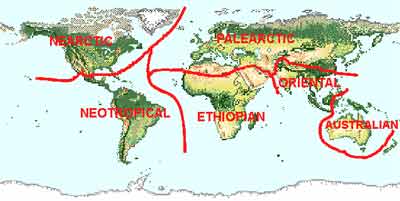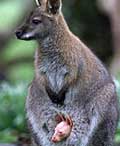THE NATURAL ENVIRONMENT
Geography 101
ToC
LIFE
Animals
Biomes
Tropics
Temperate
Cold
Hawai'i
Animals
|
|
BOX 1 |
Biogeography is the study of the distribution of living things. Biogeographers map the distributions of species, groups of species, and whole ecosystems, and then try to explain how and why that distribution developed. Within biogeography are two branches, the study of the distribution of vegetation and the study of the distribution of animals, also called zoogeography.
We begin with broadly recognized Zoogeographic Realms. Because animals are mobile, there are many thousands of species common to two or more Realms. Nonetheless, each of the Realms shown on the map has a core of quickly recognizable species that distinguish it. If I asked you which Realm contained giraffes and zebras, you would immediately think of sub-Saharan Africa, the Ethiopian Realm. How about kangaroos? The Australian Realm. Grizzly bears and pronghorn antelope? Nearctic. Giant sloths and llamas? Neotropical.

 The
distinctions between Realms are based largely on the mammals they contain.
The oddest
collection of mammals is found in the Australian Realm,
dominated by marsupials and including Earth's only remaining egg-laying mammals. These two groups diverged from the placental mammals that
dominate all other Realms over 100 million years ago. The three mammalian groups are distinguished by different strategies for raising their young. Marsupials give
birth to very tiny babies, about the size of an American nickel, who then crawl into their mother's pouch to
finish developing. A nursing pouch is the distinguishing feature of all
marsupials. This strategy provided better protection for their
young than simply laying eggs. It was not
as effective, however,
as allowing
the
fetus to
develop much longer inside the mother's womb. The
young of placental mammals share nutrients and oxygen
with the mother through a placenta
organ, which allows birth to be delayed until
they are much more capable of survival.
The
distinctions between Realms are based largely on the mammals they contain.
The oddest
collection of mammals is found in the Australian Realm,
dominated by marsupials and including Earth's only remaining egg-laying mammals. These two groups diverged from the placental mammals that
dominate all other Realms over 100 million years ago. The three mammalian groups are distinguished by different strategies for raising their young. Marsupials give
birth to very tiny babies, about the size of an American nickel, who then crawl into their mother's pouch to
finish developing. A nursing pouch is the distinguishing feature of all
marsupials. This strategy provided better protection for their
young than simply laying eggs. It was not
as effective, however,
as allowing
the
fetus to
develop much longer inside the mother's womb. The
young of placental mammals share nutrients and oxygen
with the mother through a placenta
organ, which allows birth to be delayed until
they are much more capable of survival.
Having a placenta turned out be a big evolutionary advantage and wherever the two groups lived together marsupials died out, with a few exceptions like the opossums of North and South America. Australia, however, became detached from the other continents and drifted in isolation across the Southern Ocean; placental mammals did not have the opportunity to colonize it. Thus, a unique and ancient collection of marsupial mammals survived as a kind of living museum for tens of million of years.
 Marsupials
are not Australia's only living relic.
Marsupials
are not Australia's only living relic.  Two
representatives of an even earlier mammalian group, the egg-laying
monotremes,
survive there
as well: the platypus and the echidna, or spiny anteater. These animals
are truly living fossils whose continued existence is a marvelous, random
accident of geology and biology.
Two
representatives of an even earlier mammalian group, the egg-laying
monotremes,
survive there
as well: the platypus and the echidna, or spiny anteater. These animals
are truly living fossils whose continued existence is a marvelous, random
accident of geology and biology.
Interestingly, marsupials developed similar body shapes to placentals
to fill similar niches in their environments. The most obvious example
is the Tasmanian wolf, the last of which died in a cage in 1936. It
looks identical to placental canine carnivores, but is, in fact, a marsupial
mammal complete with nursing pouch.
Of course today, Australia is overrun with placental mammals and the splendid isolation and preservation of the marsupials and monotremes is over. The continent teems with horses, cows, rabbits, cats, dogs, sheep, rats, pigs, deer, goats, ferrets, camels, and, of course, humans. Indeed, one half of the native marsupials of Australia have become extinct in the past 200 years.
 Marsupials originally populated the Neotropical
Realm of South and Central America, but successive waves of placental
mammals gradually replaced
all of them except the opossum and opossum rat. About 60 million years ago
the primitive edentate group arrived represented today by
the armadillo, sloth, and giant anteater. More recently, 20-40 million
years ago, rodents and the New World monkeys joined them, somehow migrating from Africa. About one half of the New World monkey species
are distinguished by having prehensile
tails, which can grip tree branches. These original placentals have been somewhat
displaced by a recent flood of mammals from the north, such as llamas
and jaguars, which were able to enter the continent when the land bridge
of Central America
formed
about
two million years ago.
Marsupials originally populated the Neotropical
Realm of South and Central America, but successive waves of placental
mammals gradually replaced
all of them except the opossum and opossum rat. About 60 million years ago
the primitive edentate group arrived represented today by
the armadillo, sloth, and giant anteater. More recently, 20-40 million
years ago, rodents and the New World monkeys joined them, somehow migrating from Africa. About one half of the New World monkey species
are distinguished by having prehensile
tails, which can grip tree branches. These original placentals have been somewhat
displaced by a recent flood of mammals from the north, such as llamas
and jaguars, which were able to enter the continent when the land bridge
of Central America
formed
about
two million years ago.
 The Oriental and Ethiopian
Realms have
many similar species that have diverged in recent geologic time because
of the formation of the wide, impassable Sahara desert. Earlier,
however, a great deal of migration took place between the two Realms.
They contain
the
world's only rhinoceroses, elephants, and apes. Placental
mammals originated here and marsupials became completely extinct.
The Oriental and Ethiopian
Realms have
many similar species that have diverged in recent geologic time because
of the formation of the wide, impassable Sahara desert. Earlier,
however, a great deal of migration took place between the two Realms.
They contain
the
world's only rhinoceroses, elephants, and apes. Placental
mammals originated here and marsupials became completely extinct.
The Palearctic and Nearctic Realms also contain similar fauna, as animals have been able to migrate between the two Realms on land bridges formed when sea levels were lower than today. Harsh climate characterizes these areas where only hardy animals survive, such as bison, mountain goat, bear, and the horse.
